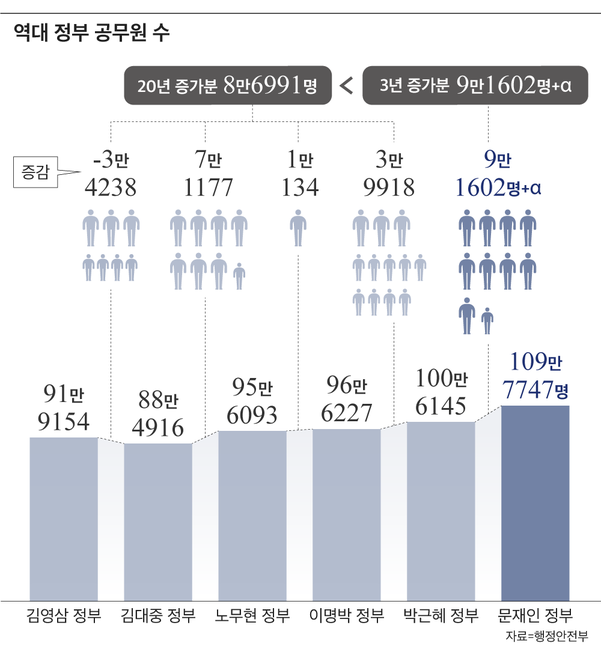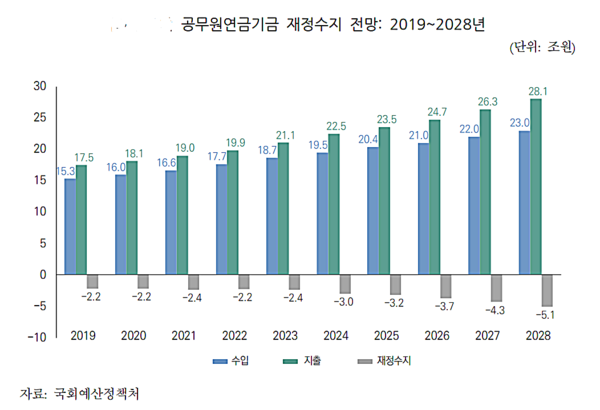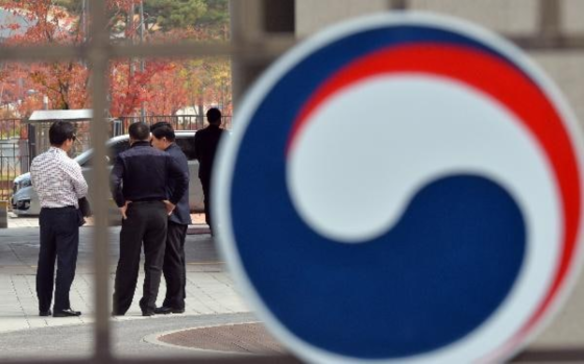Enter 2021.01.15 06:00
After the inauguration of the Moon Jae-in administration, the number of civil servants increased by 9,1602
vs 83,6991 public officials increased by 2017 after the IMF foreign exchange crisis
The Munjeongbu government increased the number of civil servants by an average of 7 times per year than the government over the past 20 years
‘Increase of public officials → increase in government organizations → strengthen regulations → decrease economic vitality’
It is estimated that the number of public servants in state and local offices (including firefighters and police officers) increased by more than 90,000 since the inauguration of the Moon Jae-in administration. The number of civil servants increased by more than 4,000 over the past 20 years before the Moon Jae-in administration was launched.
If you compare the average annual number of new public officials hired, you can see a much more dramatic difference. In the past 20 years, the number of public servants increased by an average of 4,300 per year, but during the three years of the Moon Jae-in administration, more than 30,000 public officials were selected per year. In terms of the annual average number of new recruits, it is analyzed that the current government is more than seven times the number of recruits in the previous 20 years.
As President Moon Jae-in’s pledge to increase the number of public officials in the term of office of 174,000 and to overcome the employment stagnation caused by the novel coronavirus infection (Corona 19), the government has pushed to expand hiring in the public sector, and the government’s hiring of public officials is expected to increase in the future. to be.
–
–
According to the Ministry of Public Administration and Security and the government organizational management system on the 15th, as of June 30, last year, the number of government officials in the administration was 1.07,747. The number of public officials in the administration is the combined number of national and local positions, consisting of 73,3027 national and 36,4720 local employees. The firefighting job was initially classified as a local job, but was converted to a national job in April last year due to the promise of the Moon Jae-in administration. An official from the Ministry of Public Administration and Security said, “The data on the number of public officials as of the end of last year are currently being compiled, but it is expected to increase more than in the first half.”
The number of civil servants in the Moon Jae-in administration increased by 91.62 over the three years. As of May 9, 2017, when the Park Geun-hye administration ended, the number of public servants was 1,06145. The Park Geun-hye administration increased the number of public servants by 39,918 compared to the end of the term of office of the Lee Myung-bak administration (96,6227), and more than doubled the number of recruits. The Lee Myung-bak administration increased the number of public servants by 10,134 more than the Roh Moo-hyun administration (95,6093). On the other hand, at the end of the Kim Dae-jung administration’s term of office (88,4916), a decrease of 34,238 people from the previous government, Kim Young-sam (91,9154).
The number of public servants increased over the past 20 years from 1997 when the IMF (International Monetary Fund) financial crisis took place to the days of the Park Geun-hye administration totaled 86991. The increase in the number of public servants in the Moon Jae-in administration exceeds that in the previous 20 years. As the Moon Jae-in administration’s term of office remains until May next year, the gap in the number of public servants is expected to widen further. The difference in the number of increase compared to the number of public servants (55,52) that the governments Lee Myung-bak and Park Geun-hye, who were in power in the conservative governments over the nine years, is 1.8 times.
–

–
The problem is that the government is continuing the line of expanding recruitment of public officials and public institutions as an employment expansion policy to overcome the Corona 19 crisis. The government is continuing to expand 174,000 public officials according to the ‘5-year roadmap for job policy’ announced in October 2017.
The government announced on the 13th that it will increase the number of government officials this year by about 30,000 this year, when the annual employment trend in 2020 was announced, when the number of employed people last year decreased by 210,000, the largest after the IMF financial crisis. This is because the public sector should play a role in overcoming the employment recession. The total number of employees is 16,000 national and 13,000 local employees. In addition, it plans to hire more than 30,000 new personnel essential to the public, such as police, sea police, and fire, and newly recruit 6,450 candidates for the 5th, 7th and 9th class of state officials and diplomat. A government official said, “If public institutions and public officials are combined, the number of hiring personnel is expected to exceed 70,000.”
◇The number of public jobs is also increased by 1,040,000… Labor cost and pension burden increase
After the Corona 19 incident, the pace of the government’s growth is getting faster. This is because they are struggling to increase government agencies under the pretext of strengthening the role of the government in order to overcome the Corona 19 crisis such as the employment stagnation. The government also decided to increase 1,040,000 temporary public jobs provided by taxes. Of these, 800,000 is the goal to finish hiring by March this year.
Experts pointed out that it is inevitable that the role of the government will increase due to the increase in demand for quarantine and health care after the coronavirus outbreak, but the side effects of expanding government agencies that increase the number of public servants are more significant. As the number of government bodies increases, of course, regulations increase and the vitality of the private economy inevitably decreases. On the other hand. Increasing labor and pension expenditures due to increased hiring of public officials is a factor that increases the national fiscal burden.
–

–
In addition, as the number of public servants increases, the burden on public employee pensions is also increasing. According to the data on the ‘8 Social Insurance Fiscal Forecasts for 2019-2028’ released in November 2019 by the Office of the National Assembly Budget Office for Estimation and Taxation, the pension deficit for public servants will increase from 2.2 trillion won in 2019 to 5.5 trillion won in 2028. This is because the increase in expenditures such as pension amount has increased compared to income.
“Employment is the highest priority among economic indicators that the public can feel, so the government continues to care,” said Sung Tae-yoon, professor of economics at Yonsei University. In addition, there may be side effects such as increased financial burden. The government must find a way to revitalize the private economy.”
–
– .


